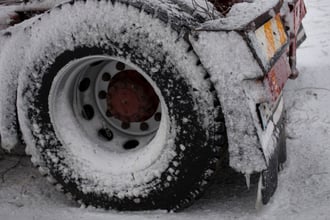
We are all familiar with drivers that swear by their method of checking tire pressures, such as the wooden club or a small baseball bat and the penny for checking tread depths. But there is no better substitute for a tire pressure and tire depth gauge.
Insufficient tire inflation pressure during the wintertime will cause many headaches for drivers and dispatchers come springtime and as temperatures begin to rise.
For every ten*F change in temperature, a tire loses or gains 1 to 2 PSI. A tire study conducted by The American Trucking Associations’ Technology and Maintenance Council showed that 90% of tire failures can be traced back to improper tire inflation. In the first three quarters of 2020, the VMRS code 017, Tires remained one of the top 5 roadside breakdowns amongst all verticals according to the TMC/FleetNet Vertical Benchmarking Program Executive Summary.
Positioning your fleet’s tire program for success going into and coming out of the winter months sounds complicated, but it’s simpler than you think. Getting the drivers to understand the importance of proper tire inflation pressures is critical. Having a plan to engage the drivers before and during the winter months will ensure a successful outcome in the spring. Purchasing tire pressure and tire depth gauges for the drivers to keep in their tractor will encourage them to use the tools.
Drivers checking tire pressures will help prevent moisture build-up that can occur in the valve stem from freezing. Freezing of the moisture expands and creates a pathway for air to escape, thus reducing tire pressures. The continuous cycle of tires expanding and contracting will damage the tire itself, making it more brittle, thus exacerbating wear.
When a driver experiences a tire blowout in the winter, they need to check that the new tire has the same tread depth as the others to avoid uneven wear. It is important to remind drivers that a tire of different size will be carrying much more of the load than the one next to it, leading to quicker wear and heating of the tire.
Under-inflated tires can lead to the following:
- Increased stopping distance can cause skidding on wet pavement despite having ABS
- Poor fuel economy. According to the U.S. Department of energy, for every 1 PSI drop in tire inflation pressure, a vehicle will lose 0.2% in fuel economy
- The decreased life span of the tire through early deterioration from expansion and contraction of the rubber
A successful winter tire maintenance includes involving the driver. Through pre-and post-trip inspections, the driver will be the first line of defense for winter tire maintenance and help your fleet be successful come spring and summer.


%20Cropped.jpg)



